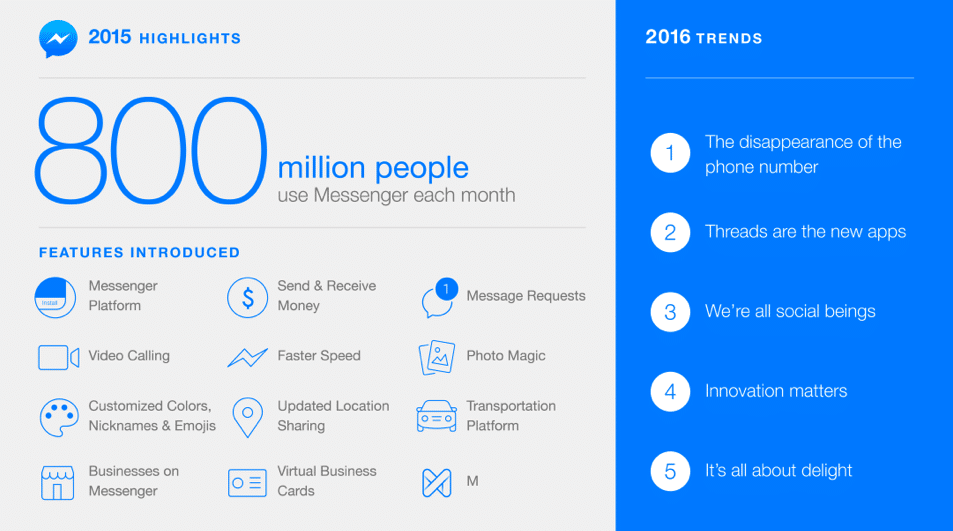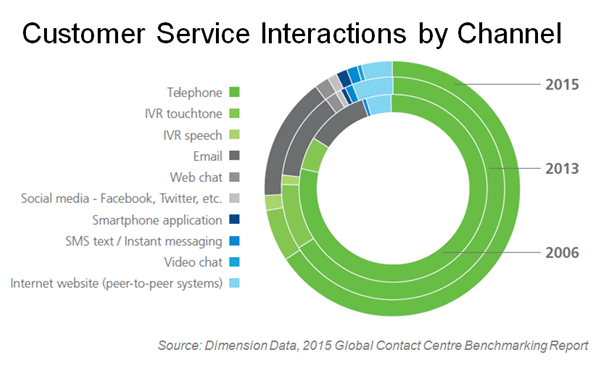Webcare: the new call centre
Social media has changed how customers find companies in recent years, but the phenomenon of customer-service organisations also using “social” for their helpdesk is still relatively new. Offering customer service via social media has the potential to open many doors, but it is important that it is tackled properly.
An increasing number of companies have become aware of the opportunities of recent developments; in today’s world more than 35% of all customer interactions are handled digitally. IT company Dimension Data states that, should this growth continue, there will be more digital interactions than via telephone in two years. This trend forces companies to look at social media differently. There are many benefits to offering customer service via social media, and the developments are following each other at a rapid pace.
Public
Social media have made brands more accessible for customers and completely changed their expectations by making them visible. Complaints, problems and customer questions are suddenly on the internet; visible to everyone and easily findable. By adequately organising their digital customer service, companies can garner a lot of praise and considerably increase their NPS (Net Promoter Score). At the same time, if a company provides a bad online service, this means that every time somebody looks for that company online, the lacking quality of its online service will reflect negatively on the company. This makes it vital to tackle this properly.
Busy
Social media never stops and users can be found making use of it around the clock. As a result, pressure on companies to be available outside of office hours is rising. An increasing number of them are starting to search for a solution, but most small-to-medium-sized organisations cannot even manage one network effectively, let alone multiple networks. To still meet the needs of the customer, a rising number of companies are opting for specialised, external support.
More chat in the helpdesk
Customer service is increasingly being conducted via written messages on digital media in today’s world. This is a significant change. Live chat is a considerable part of this. An analyst in the contact-centre industry, the British company ContactBabel, conducted research into this and found that in the year 2013, there were roughly 250 million chats an impressive rise of 60 percent in a year. With 2011 as the starting point, this constitutes a rise of more than 300% by the end of 2014.
Succes
Companies such as HP and KLM have already shown that good webcare can reach higher results. HP, for example, achieved that its webcare employees within Europe can process almost 50 percent more customers daily. On top of that, Facebook and Twitter questions are processed almost twice as fast.
KLM processes some 60,000 messages every week in multiple languages and on many different social media platforms. At the same time, KLM is experimenting with a WhatsApp messaging service. In 2014, their webcare generated an additional 25 million euros for the company on top of the company’s other revenue streams.
These are examples of companies that use webcare to properly run their customer service, but things can also be done badly. Communication platform NewVoiceMedia estimates that in England companies forego up to 12 billion pounds annually because of customers switching to the competitor due to bad service. This is something companies clearly want to prevent from happening.
So, if the adequate application of webcare can generate such results, why don’t all companies employ webcare? Market researcher Gartner states that this is only a question of time and expects that, within five years, social media will be employed by roughly 90 percent of companies for their customer service. But to get to that point, companies today must take action.
Not the right skillset
The initiative to utilise social platforms for customer service often starts in the marketing department, since this is the department that works with social media channels. Sadly, this department is usually not able to track large numbers of these types of interactions.
This is even challenging for the customer-service department. They do not possess the right social media skills, are used to spend more time on their messages and often also write in long sentences. However, the manner of writing is very different on social media, where the messages must be kept short and concise.
The best strategy
In terms of webcare, companies that use both internal and external people have adopted the most effective strategy. In recent years, various services and products have been developed that offer varying aspects of social media services. Companies can now select social media monitoring, dealing with customer questions and complaints, business intelligence, or a combination of various services.
Social media
The overwhelming majority of the time (roughly 91 percent)we spend on our computers and mobile phones is spent chatting. Unsurprisingly, social media make up a large part of webcare. Therefore, it is important to zoom in on this quickly. A study by Marketingfacts showed that, presently, the largest part of messages on social media are sent via Facebook or Twitter. Both companies have a roughly equal share in this.
Public or not?
Although social media generates considerable openness, not all messages sent via social media are public; 47 percent of the messages are private messages. Thus, consumers choose to send messages that are shielded from the public in almost half of the cases. This is the reason for Facebook and Twitter to investigate the option of also sending private messages via their media channels.
Messenger for Businesses
To give an example, Facebook, also the owner of WhatsApp, is working hard at developing Messenger for Business. This will allow companies to use the messaging service in their communication with consumers. In the infographic below, Facebook has created an interesting overview of its achievements in 2015, but also what their expectations are for the coming year.

Facebook says that it wants to change how companies communicate with customers. Owner Mark Zuckerberg says that giving companies the option of having good contact with their customers opens the door to greater revenues. With more than 800 million users by the end of 2015, this certainly seems like an option for Messenger. The number of users of the app is growing at an incredible pace.
While it is already possible to send and receive money through Messenger, Facebook has even more plans. For example, it wants to provide the option of sending invoices or updates concerning its shipments, but it also wants to use it to process complaints and questions – something the Chinese chat app, WeChat, can already do. In China, users can already use the application to buy cinema tickets or pay for bills.
WhatsApp: great potential
Although I previously mentioned WhatsApp, this application deserves a little extra attention. This is because this chat app has many options and great potential. WhatsApp is currently the world’s largest chat app. It has an impressive 900 million users, which is 100 million more than Facebook’s Messenger. Not just Schiphol is experimenting with WhatsApp for its customer service; Transavia, ING, KPN and NEM have also discovered it. Transavia is making considerable progress: roughly half of its contact with customers is taking place via WhatsApp..
Currently, only 11 percent of Dutch companies are using the application in their customer-service mix, although eight out of ten consumers who used the service to establish contact with a company had a positive experience. This was revealed by a study conducted by Marketingfacts. This means that much ground can be won here for companies. Added to this, WhatsApp has been entirely free to use since the 18th of January 2016. This will ensure that the number of users will grow, and with that, the options and opportunities for companies.
WhatsApp has many advantages compared to other messaging services. It is fast, much more personal and more private than other channels. Nonetheless, TNS Nipo points out that contact via WhatsApp isn’t everybody’s cup of tea, and therefore advises companies to “make segmented use” of the service.
More informal
The Marketingsfacts study also revealed that in only ten percent of the social media based conversations, communication is formal. Most of the conversations are simply closed off with “regards” and a first name, or initials on Twitter. Also, in 88 percent of conversations, webcare employees use “I” and not “we”, making the conversations even more informal. It is often specifically the informality of the medium that customers want, since this is what they can also expect on the phone.
Challenges
Like with all new developments, there are also some challenges involved with providing webcare. In his early 2015 report, ‘How to Manage Social Media Engagements for Customer Service’ vGartner outlines different aspects. One of the things he mentions is that companies often do not see that the splitting up of webcare and a more traditional customer service can create inconsistency in the way customers experience contact with the company. This can have a negative effect on results. Another example is that many organisations have difficulty meeting the demands of 24/7 webcare, or lack of a clear and well-defined approach plan concerning providing webcare.
However, there is another reason customer service via social media is not always approached as effectively as it could be by companies. The hiring and training of the right employees to manage interactions via social media is an important area in which many companies are found lacking. A webcare employee requires a whole different skillset than the “traditional” telephone-based employee. An “ordinary” call-centre employee, therefore, is not always necessarily a good webcare employee.
Webcare employees must be able to use advanced software to analyse social networks or conduct social mining, for example. This allows them to swiftly respond to events and customer interactions. It is a more technical approach that involves more written communicative skills, while employees working by telephone must be verbally competent.
Tips
Companies that have made the decision to outsource (part of) their social media tasks should consider the following points. Firstly, it is almost impossible to stay up to date concerning all aspects of social media. Social media is highly dynamic, which makes it important to carefully select a partner. It is highly recommendable to only work with seasoned professionals.
Additionally, some service providers claim to be “sector-specific”, but this doesn’t mean a whole lot. To realise your business objectives, it is important that your webcare provider knows how to deliver good webcare, how to meet customer needs and build relationships with customers. Good webcare can be employed similarly across all sectors, making having an adequate methodology far more important.
Finally, it is recommendable to ask service providers for their SLA (Service Level Agreement). Share your own, up-to-date statistics of the contact centre and focus conversations around metrics and KPIs; an open and honest discussion in which the groundwork for a trusting relationship is laid.
Customer communication is not what it once was. With current developments, it is important that companies quickly grasp in which way they can offer the best possible service. Customer service is slowly shifting from telephones and emails towards social media, live chat and mobile apps. These developments are picking up pace, which is why it is important for companies to quickly find out what webcare can do for them.



